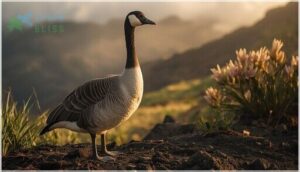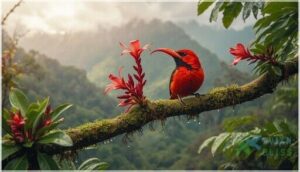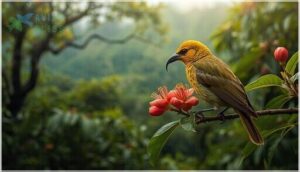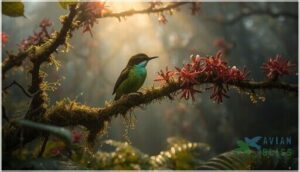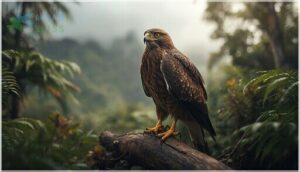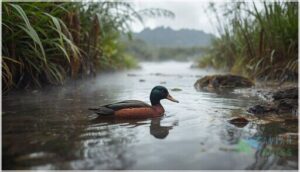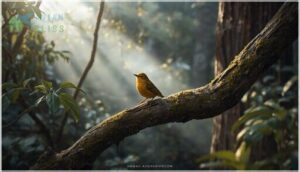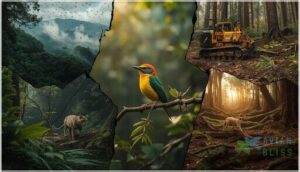This site is supported by our readers. We may earn a commission, at no cost to you, if you purchase through links.
Two-thirds of Hawaii’s native bird species are already gone, wiped out since humans first arrived on the islands. The survivors cling to shrinking forests, battling invasive predators, mosquito-borne diseases, and habitat loss that has claimed 1.5 million acres of native woodland.
Yet hope persists in unexpected places. The Hawaiian Goose has rebounded from near-extinction to nearly 3,900 individuals, while researchers have discovered that some species like the Hawaii Amakihi are developing resistance to avian malaria.
You’ll find over 350 bird species across the Hawaiian Islands today, from the vibrant red Iiwi pollinating native blossoms to invasive mynas spreading through urban neighborhoods. Understanding which birds belong here and which threaten the ecosystem helps you appreciate the conservation battles being fought to preserve these special species.
Table Of Contents
- Key Takeaways
- Native and Endemic Birds of Hawaii
- Common Invasive Bird Species
- Waterbirds, Seabirds, and Birds of Prey
- Threats Facing Hawaii’s Birds
- Birdwatching and Conservation Efforts
- Frequently Asked Questions (FAQs)
- What bird species live in Hawaii?
- How many bird species are there in Hawaii?
- Are there forest birds in Hawaii?
- What is the state bird of Hawaii?
- What is the most famous bird in Hawaii?
- Where can you see birds in Hawaii?
- What bird is common to Hawaiʻi?
- What are the national birds of Hawaiʻi?
- What is the rarest bird in Hawaiʻi?
- What is the big bird in Hawaiʻi?
- Conclusion
Key Takeaways
- Two-thirds of Hawaii’s native bird species have vanished since human arrival, with survivors now battling invasive predators, mosquito-borne diseases like avian malaria that kill 90% of infected honeycreepers, and habitat loss that’s claimed 1.5 million acres of native woodland.
- Conservation successes like the Hawaiian Goose rebounding from 30 individuals in 1951 to nearly 3,900 today, plus emerging disease resistance in species like the Hawaii Amakihi, show that targeted recovery efforts combining predator control, habitat restoration, and disease management can reverse decades of decline.
- Invasive bird species including Common Mynas, Zebra Doves, and feral chickens now outnumber many native species and actively harm ecosystems by spreading avian malaria, destroying crops worth hundreds of thousands annually, and competing with endemic birds for limited resources.
- Climate change threatens to push avian malaria-carrying mosquitoes into high-elevation forest refuges where the last native birds survive, potentially eliminating over 50% of remaining habitat by 2100 unless urgent interventions like sterile mosquito releases and expanded habitat protection succeed.
Native and Endemic Birds of Hawaii
Hawaii’s isolated geography has given rise to some of the most unique birds on the planet, with 64 species found nowhere else on Earth. Many of these endemic species face serious threats today, making them all the more special to encounter in the wild.
Here’s a closer look at the native birds you might spot across the Hawaiian Islands.
Hawaiian Goose (Nēnē)
You’re looking at Hawaii’s official state bird, the Nēnē, a native Hawaiian bird species that came back from the brink. This endemic bird species dropped to just 30 individuals in 1951.
Hawaii’s state bird, the Nēnē, nearly vanished with just 30 individuals left in 1951 before staging a remarkable comeback
Today, thanks to habitat restoration, predator control, and public awareness campaigns, the Hawaiian goose population has climbed to nearly 3,900 birds. The species was downlisted due to successful conservation efforts.
Road mortality remains a concern, but this endangered species recovery story offers real hope.
Iiwi
The ‘I’iwi stands out among Hawaiian honeycreepers with its vibrant scarlet feathers and curved bill. This endemic bird species functions as a primary pollinator for native plants like ‘ōhi’a, making its ecological role irreplaceable.
Unfortunately, population trends show sharp declines—Kaua’i populations have dropped 92% over 25 years. Avian malaria remains the biggest conservation threat, killing roughly 94% of infected individuals.
The ‘I’iwi habitat now centers on high-elevation forests where mosquitoes can’t thrive, though climate change keeps pushing disease vectors higher. As an endemic Hawaiian honeycreeper, its survival is closely tied to forest health.
Hawaii Amakihi
Unlike its scarlet cousin, the Hawaiʻi ʻAmakihi wears olive-yellow plumage that blends into native forests. This endemic bird shows considerable disease resistance—populations have actually rebounded in low-elevation areas despite avian malaria.
You’ll find these Hawaiian honeycreepers across diverse habitat preferences:
- Subalpine ‘ōhi’a scrub on Hawai’i Island
- Māmane forests on Mauna Kea
- Koa reforestation zones
- Wet montane forests on Maui
Their genetic diversity remains high, supporting ongoing bird conservation efforts.
Omao
The Ōmao, a small endemic thrush, calls Hawaiʻi Island home. This native bird plays an important role in seed dispersal—85% of analyzed droppings contained seeds from seven plant species.
Population decline has pushed this Hawaiian bird species into just 30% of its former range. Juvenile survival sits around 40%, though conservation successes like pig removal at Hakalau Forest have helped stabilize habitat preference zones.
Akekee
The ʻAkekeʻe ranks among Hawaiʻi’s most critically endangered species. This small honeycreeper now clings to roughly 58 km² of high-elevation forest on Kauaʻi, with fewer than 638 individuals remaining.
Population decline has been devastating—98% since 2000. Avian malaria, spread by mosquitoes reaching higher elevations due to warming temperatures, poses the greatest threat.
Conservation initiatives include captive breeding and habitat restoration efforts.
Palila
The Palila stands as one of Hawaiʻi’s most vulnerable endemic birds. You’ll find this endangered species only in māmane forests on Mauna Kea’s slopes, where māmane dependence defines its survival—90% of its diet comes from these seeds.
Population decline has been severe:
- Dropped from nearly 6,000 birds to roughly 679 individuals
- Current range covers just 10% of historical habitat
- Habitat restoration and predator control efforts continue
Future viability remains uncertain for this native bird, though conservation efforts show early promise.
Hawaiian Hawk (‘Io)
The Hawaiian Hawk, or ‘Io, is the only raptor endemic species among Native Hawaiian birds. You’ll spot this forest habitat specialist across Hawai’i Island, from sea level to 6,500 feet.
Its Io ecology has shifted dramatically—invasive diet now dominates, with rats comprising 65% of prey biomass. Breeding habits include lifelong pair bonds and 1-2 eggs annually.
Conservation status improved in 2020, though conservation efforts continue protecting Bird Habitats in Hawaii.
Hawaiian Petrel
You won’t find the Hawaiian Petrel just anywhere—this endemic species nests in high-elevation burrows above 8,200 feet on five islands.
Sadly, population decline has been steep, with Kaua’i seeing a 78% drop between 1993 and 2013.
Predator control efforts and translocation success stories offer hope, though. At monitored sites, 96% of chicks now survive to fledging during their breeding cycle.
Hawaiian Duck
The Hawaiian Duck, or Koloa, stands alone as the last native duck species calling the main islands home. With only 2,200 birds remaining and hybrid removal programs in full swing, conservation efforts focus on habitat restoration and protecting wetland ecosystems that support population estimates across Kaua’i, Hawai’i Island, and beyond.
- Kaua’i’s 2,000 birds represent the purest genetics left
- Mallard hybridization threatens the species’ survival on O’ahu and Maui
- Coastal wetlands have shrunk by 31% over the past century
- Feral predators destroy nests before chicks ever take flight
Hawaiʻi ʻAkepa
You’re looking at one of Hawaii’s rarest treasures when you spot a Hawaiʻi ʻAkepa flitting through old-growth ʻōhiʻa forests above 1,400 meters. This critically endangered honeycreeper—down to just a few thousand individuals—faces habitat fragmentation, avian malaria spreading upslope with climate change, and limited nesting cavities in mature trees. Recovery planning demands $2.48 billion over 30 years to protect this and 20 other endemic birds alongside the Hawaiʻi ʻamakihi.
| Challenge | Impact on ʻAkepa |
|---|---|
| Avian malaria at lower elevations | Forces birds into shrinking high-altitude refuges |
| Habitat fragmentation from logging | Reduces nest-site availability in old ʻōhiʻa stands |
| Delayed plumage maturation (4 years) | Limits breeding population despite genetic diversity |
| Climate warming effects | Pushes disease zones upward into last safe havens |
Common Invasive Bird Species
Not every bird you spot in Hawaii belongs there. Over the years, humans have introduced dozens of species that now outnumber some of the islands’ native residents.
Here’s a look at the most common invasive birds you’ll encounter during your visit.
Red-crested Cardinal
Sporting a crimson crest and silver bill, the Redcrested Cardinal (Paroaria coronata) arrived from Brazil between 1928 and 1931 and now thrives in lowland parks across the Hawaiian introduction sites. Its urban adaptation skills shine through:
- Foraging on grass seeds and insects in lawns
- Nesting in ornamental shrubs with greenish spotted eggs
- Reproducing year-round in irrigated landscapes
Conservation status remains stable as a non-native bird species with minimal impact on Hawaii’s native bird identification priorities.
Zebra Dove
Unlike its cardinal cousin, the Zebra Dove (Geopelia striata) blends into Hawaii’s dry lowlands with barred plumage that echoes fence posts. Since introduction, population trends show O’ahu hosting 70,000 individuals—often flocking by the thousands near water sources.
Breeding habits include year-round nesting with five broods annually, while habitat adaptation spans urban parks to 1,000 m elevations.
Their ecological impact? Spreading avian malaria to vulnerable native species, demanding careful management strategies.
Common Myna
The Common Myna (Acridotheres tristis) arrived in 1865 to control sugarcane pests but became Hawaii’s loudest invader. Their ecological impact hits hard: they usurp native bird nests, spread invasive Lantana seeds, and damage fruit crops. You’ll spot these chocolate-brown birds with yellow eye patches everywhere—urban parks, beaches, even 3,000-meter elevations. Control measures include trapping and exclusion, though their adaptability makes management challenging.
Western Cattle Egret
Western Cattle Egrets (Bubulcus ibis) came to Hawaii in 1959 from Florida—105 birds released to control cattle pests. Their population exploded to 30,000 by 1981, establishing colonies across all main islands.
These white waders with golden breeding plumes now threaten endangered Hawaiian Stilts and Coots, raiding nests in wetlands. Control methods include nest destruction and shooting, though populations rebound quickly after interventions cease.
Red-vented Bulbul
The Red-vented Bulbul (Pycnonotus cafer), identified by its black crest and namesake red patch, arrived illegally in Hawaii during the 1950s. Established on Oahu, you’ll recognize this invasive bird species through its loud calls and aggressive behavior.
It damages orchids worth over $300,000 annually while spreading seeds of miconia and ivy gourd—harmful invasive plants threatening native watersheds and competing with Hawaii’s endemic birds.
Red Junglefowl
Polynesians brought Red Junglefowl (Gallus gallus) to Hawaii around 1200 AD, but today’s feral chickens—especially Kauaʻi’s famous 450,000—are hybrids with domestic breeds. Hurricanes in the 1980s and ’90s destroyed coops, accelerating hybridization and creating invasive bird species in Hawaii that now outnumber people.
These introduced bird species and feral birds act as disease reservoirs for avian malaria while damaging crops:
- Genetic diversity dilutes pure Red Junglefowl ancestry
- Population control efforts have stalled repeatedly
- Agricultural pests destroy native crops
- Their ecological role spreads invasive plant seeds
Waterbirds, Seabirds, and Birds of Prey
Hawaii’s coastal and aquatic environments host an exceptional range of waterbirds, seabirds, and birds of prey that have adapted to the islands’ unique ecosystems. You’ll find native species that wade through wetlands, soar over open ocean, and even hunt across remote coastal cliffs.
Here are some of the most distinctive birds you might encounter in Hawaii’s waters and skies.
Hawaiian Stilt (Ae’o)
You’ll recognize the Hawaiian Stilt, or Ae’o, by its striking black and white plumage and long pink legs wading through coastal wetlands.
This endemic bird’s population hovers between 1,500 and 1,800 individuals—gradually rebounding from a devastating low of just 200 in 1941. Conservation management and habitat protection across Maui, Oʻahu, and Kauaʻi’s wetlands remain critical for breeding success and continued recovery.
Hawaiian Coot (Fulica Alai)
The Hawaiian Coot (Fulica alai), or ‘Alae Ke’oke’o, inhabits Hawaii’s freshwater wetlands with a population of 1,500 to 2,000 individuals—concentrated on Kauaʻi, Oʻahu, and Maui. This endemic waterbird thrives through targeted conservation efforts.
These efforts include:
- Habitat restoration creating protected nesting zones in marshes and taro fields
- Predator control reducing mongoose and rat threats
- Nesting success monitoring showing 58% of nests producing chicks
The diet ecology of the Hawaiian Coot includes aquatic insects, seeds, and plants.
Black-crowned Night Heron (‘Auku’u)
The Black-crowned Night Heron (‘Auku’u) stands as the only resident heron in the Hawaiian Islands, occupying wetlands from mountain streams to urban ponds.
You’ll spot these stocky waterbirds foraging after dark, using specialized bill-vibrating techniques to catch fish, crustaceans, and insects.
Their urban adaptation allows them to thrive in artificial habitats, though wetland loss—31% over 110 years—and DDT sensitivity threaten their stability.
Laysan Albatross (Moli)
Among Hawaii’s seabirds, the Laysan Albatross (Moli) shows considerable resilience despite mounting challenges. These native birds form lifelong bonds and return annually to Northwestern Hawaiian Islands colonies, where over 90% of the 2.5 million global population breeds. You’ll find their conservation efforts focused on four critical threats:
- Plastic ingestion causing chick mortality
- Tsunami impact (212,000 chicks lost in 2011)
- Climate-driven habitat loss
- Longline fishery bycatch
Their foraging ranges extend 2,000+ kilometers across the Pacific, making breeding success vulnerable to oceanic changes. As endangered species indicators, declining albatross populations signal broader marine ecosystem health concerns.
Pacific Golden Plover
You’ll spot Pacific Golden Plovers (Kolea) across Hawaii’s beaches, lawns, and golf courses from August through April—part of their impressive 3,000-mile migration from Alaska. These shorebirds defend winter territories individually, feasting on insects and crustaceans.
While globally stable at 220,000 individuals, they’re a Species of Greatest Conservation Need here due to habitat loss from sea level rise and climate shifts affecting their migratory patterns and Arctic breeding grounds.
Great Frigatebird
Great Frigatebirds glide above Hawaii’s Northwestern Islands, where around 10,000 breeding pairs nest in colonies—Nihoa and Laysan host the largest.
You’ll recognize their kleptoparasitism behavior, stealing fish from boobies mid-flight. Parents care for chicks up to 18 months, among the longest parental care periods in seabirds.
Their foraging range extends 80 km from nesting colonies, where population trends remain stable thanks to predator-free seabird habitats and ongoing conservation efforts.
Wedge-tailed Shearwater
If you’re drawn to seabirds that master Hawaii’s coastlines, you’ll find Wedge-tailed Shearwaters nesting in burrows across offshore islets. Here’s what makes them fascinating:
- Over 67,000 pairs breed in the Main Hawaiian Islands
- Flying fish and squid make up 66% of their diet
- Parents share a 52–55 day incubation period
- Chicks fledge after 100–115 days of care
- Conservation status remains stable on predator-free islands
Their breeding cycle peaks in June, with foraging behavior extending up to 11 days during chick-rearing. Population trends show resilience where invasive species are controlled.
Threats Facing Hawaii’s Birds
Hawaii’s native birds face a perfect storm of challenges that have pushed many species to the brink of extinction. From vanishing forests to deadly diseases, these threats work together in ways that make recovery incredibly difficult.
Let’s look at the five major dangers threatening Hawaii’s birds today.
Habitat Loss and Deforestation
Habitat loss has hit Hawaii hard—about 1.5 million acres of native forests are gone, and two-thirds of endemic bird species have vanished since humans arrived. Deforestation drivers like ranching, logging, and urban sprawl keep shrinking what’s left.
Forest fragmentation pushes birds higher up mountains, isolating populations.
The good news? Reforestation initiatives are planting hundreds of thousands of trees, restoring critical habitat and supporting endemic bird conservation.
Invasive Predators and Species
While introduced predators may seem harmless, they’ve devastated native birds across Hawaii. The small Indian mongoose alone caused 76% of waterbird nest failures at monitored sites, while feral cats accounted for 35% of seabird deaths at breeding colonies. Invasive species like rats and barn owls compound the threat.
Without predator control through fencing and trapping, population decline accelerates. However, conservation efforts show promise, with managed colonies seeing breeding success jump 80%.
Avian Diseases (Malaria, Pox)
Beyond direct predation, avian malaria and avian pox pose existential threats to native birds through disease vectors like Culex mosquitoes. Mortality rates reach 90% in honeycreepers with limited species susceptibility defenses.
Conservation strategies now include sterile mosquito releases and habitat protection at higher elevations. Encouragingly, Hawaii amakihi populations show genetic resistance, suggesting hope for threatened species facing invasive species-driven disease pressure despite ongoing threats to bird populations.
Climate Change Impacts
Climate change threatens Hawaii’s native birds through rising temperatures that push avian malaria-carrying mosquitoes into high-elevation refuges, where mortality exceeds 90% in honeycreepers. Endemic birds face extinction without urgent bird conservation action addressing these escalating impacts of climate change.
You’ll see range contraction as species shift upward, losing over 50% of habitat by 2100. Sea level rise drowns seabird nesting sites, while weather extremes like droughts reduce breeding success.
Pollution and Human Disturbance
Plastic ingestion kills roughly one-third of albatross chicks on Midway Atoll annually, while light disorientation grounds fledgling petrels and shearwaters near urban areas.
Chemical contaminants like lead and pesticides in wetland habitats reduce nesting success for threatened species.
Habitat trampling from beachgoers collapses seabird burrows, accelerating species decline. These pressures compound habitat loss and invasive species threats, pushing endangered species toward extinction without immediate bird conservation intervention.
Birdwatching and Conservation Efforts
Hawaii’s birds face serious challenges, but there’s good news—conservation efforts are making a real difference across the islands.
Whether you’re planning a birdwatching trip or want to support recovery programs, you’ve got plenty of ways to get involved.
Let’s look at where to spot these remarkable species, who’s working to protect them, and how your interest in birding can actually help save Hawaii’s rarest birds.
Top Birding Locations in Hawaii
Birdwatching in Hawaii offers exceptional access to island endemism through carefully managed sites. Coastal hotspots such as Kīlauea Point and Keālia Pond provide refuge management for endemic Hawaiian birds and migratory species, protecting critical bird habitats.
You’ll find the most diverse native Hawaiian birds at locations like Hakalau Forest National Wildlife Refuge, where trail access and annual bird surveys document over 110,000 ‘I’iwi across 32,000 acres.
Conservation Programs and Organizations
You can support native birds through several active conservation programs working across the islands. The National Fish and Wildlife Foundation recently announced $932,000 in grant funding for Hawaiian forest bird conservation, focusing on predator control across 16,270 acres and habitat restoration.
Community engagement efforts have reached over 1,000 people, while mosquito control projects using bacterial biocontrol methods target avian disease vectors threatening endemic birds.
Endangered Species Recovery Efforts
Recovery programs for endangered species combine habitat restoration, predator management, and disease control to reverse decades of decline. Captive breeding initiatives now maintain populations of critically endangered honeycreepers like the ‘Akeke’e, while funding allocation has increased from 6.7% to 18.4% of federal recovery spending.
You’ll find habitat restoration efforts have planted over 38,000 native trees, directly supporting 11 forest bird species through conservation of bird species across the islands.
Birding Tourism and Economic Impact
Tourism revenue from Hawaii’s avian biodiversity contributes $50 million annually to local economies while supporting 740 jobs across the islands. Birding tourists spend $924 per trip on average, generating $6.2 million in tax revenue that flows directly into conservation funding.
This sustainable birding model strengthens ecosystems and bird populations simultaneously—protecting species while creating economic opportunities for communities near critical habitats.
How to Support Hawaiian Bird Conservation
You can directly support conservation efforts through volunteer programs and citizen science projects that monitor endemic birds. Practice ethical birding, reduce waste on trails, and help protect these native birds for future generations.
Donate funds to organizations restoring habitat loss and controlling invasive species—remember, just $932,000 in grants generated $1.6 million in total conservation impact in 2024.
Frequently Asked Questions (FAQs)
What bird species live in Hawaii?
You’ll find around 340 recorded bird species across Hawaii—64 are endemic birds found nowhere else, 52 are introduced species brought by humans, and 130 are accidental visitors passing through these remote islands.
How many bird species are there in Hawaii?
Hawaii hosts approximately 337 bird species, including 64 endemic or native taxa. However, 33 endemic species have gone extinct, while 52 introduced species now thrive, dramatically reshaping the islands’ avian biodiversity.
Are there forest birds in Hawaii?
Yes, native forest birds thrive in Hawaii’s high-elevation forests, though they’re increasingly rare. Habitat loss and avian malaria have pushed endemic bird species higher up mountainsides, where cooler temperatures offer refuge from disease-carrying mosquitoes.
What is the state bird of Hawaii?
Imagine a goose that forgot how to swim—meet the nēnē (Branta sandvicensis), Hawaii’s state bird since
This endemic Hawaiian Goose symbolizes conservation triumphs, inhabiting lava plains and grasslands while facing threats from introduced predators despite considerable recovery efforts.
What is the most famous bird in Hawaii?
The Hawaiian Goose (Nēnē) claims the most iconic bird status as Hawaii’s official state bird since This endemic species drives conservation bird marketing and public bird recognition, while the I’iwi attracts significant tourism bird appeal.
Where can you see birds in Hawaii?
From lush forest ecosystems to protected coastal bird habitats, you’ll find Hawaii’s avians thriving in National Parks, Wildlife Refuges, and wetland bird habitats.
Birding tourism flourishes at sites like Hawai’i Volcanoes and Kilauea Point, where forest birding meets conservation.
What bird is common to Hawaiʻi?
You’ll find the Hawaiʻi ʻamakihi leading in native bird abundance, with ʻapapane prevalence close behind.
Among introduced species, warbling white-eye density dominates, followed by common mynas and zebra doves across developed areas.
What are the national birds of Hawaiʻi?
You’ll find no “national” bird here—Hawaiʻi doesn’t have one. The state bird, the Nēnē (Hawaiian Goose), holds that honor since 1957, representing conservation efforts and cultural significance statewide.
What is the rarest bird in Hawaiʻi?
The Akikiki (Oreomystis bairdi) holds the unfortunate title as Hawaii’s rarest endemic species. With fewer than 10 individuals surviving only in captive breeding programs, extinction looms unless mosquito control and habitat restoration enable future reintroduction.
What is the big bird in Hawaiʻi?
If you’re trying to spot something with serious wingspan, you’re probably eyeing a Laysan albatross—with a population around 5 million—or a great frigatebird stretching over two meters across Hawaiian skies.
Conclusion
A single honeycreeper sips nectar from an ohia blossom while a myna screeches from a telephone wire below—two birds of Hawaii representing wildly different futures.
Your awareness matters because every species you can identify, every conservation effort you support, tips the balance toward recovery.
The native birds clinging to high-elevation forests need more than admiration. They need action, funding, and people who recognize that Hawaii’s ecological identity depends on keeping these survivors alive.
- https://dlnr.hawaii.gov/wildlife/files/2025/03/Paxton-et-al-2021-Distribution-and-trends-of-endemic-Hawaiian-waterbirds.pdf
- https://hilo.hawaii.edu/hcsu/documents/HCSU012CampetalPopulationtrendsofnativeHawaiianforestbirds1976-2008FINAL.pdf
- https://www.tandfonline.com/doi/full/10.1080/15594491.2024.2444022
- https://www.nature.org/en-us/what-we-do/our-priorities/protect-water-and-land/land-and-water-stories/saving-native-hawaiian-birds-federal-support/
- https://www.sciencedirect.com/science/article/pii/S0960982225005755


